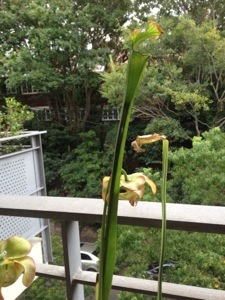These Sarracenia pitcher plants sit in a window planter that otherwise would hold only white stones. The location is good as they catch insects that might otherwise fly in to the living room (like most eastern Sydney housing we don’t have screens and the doors are open most of the time while we are home). They are also interesting to look over, with their form and red veining.
Potting is crucial for all the carnivorous plants. Sarracenias like to have cool wet roots, and fertilizer or salt buildup is certain death for them. These are in a peat, perlite, sphagnum mix, in a plastic trough with a water tray, sunk into the stones. I’ve sunk two small terra cotta pots, with their drainage holes sealed, into the mix, and these catch the drip irrigation water, which both holds it for slow release and helps cool the trough. Water straight from the tap seems to be harsh in the sphagnum, and the delay in terra cotta may also help here by allowing some chlorine to degas.
The plants are many years old, started from small and cheap nursery plants. They benefit from a top-up of sphagnum every few years, as here it doesn’t grow well enough to provide a continuous surface.
The tall slender pitcher plant is the least hardy, and the pitchers can get a little tatty due to being blown about and also because they fill with insects and can rot through. You can see with this pitcher how it’s been too successful with capture. The tall plants must be kept moist while the new pitchers are forming, or they distort.
The flowers persist long after the petals have dropped, and although they are certainly sterile I leave them as they seem to be a good photosynthetic tissue and look fine.


